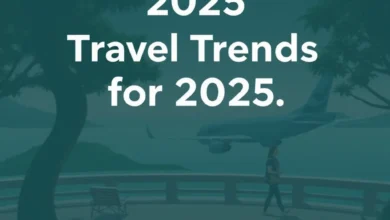Top 10 Travel Trends for 2025: The Fastest-Growing Traveler Segments

The travel industry is undergoing a remarkable transformation in 2025, driven by evolving traveler preferences, technological advancements, and global shifts in culture and economics. After years of disruption and change, the way people explore the world is more diverse and dynamic than ever. Understanding the fastest-growing traveler segments is crucial for businesses, destinations, and service providers aiming to meet the demands of modern explorers. Here’s an in-depth look at the top 10 travel trends and traveler types shaping the industry this year.
1. Experience-Driven and Immersive Travelers
Today’s travelers are no longer satisfied with simply visiting landmarks or ticking off famous sites. Instead, they crave authentic, immersive experiences that connect them deeply with local culture, history, and communities. This segment seeks out activities like cooking classes with local chefs, artisan workshops, community-based tourism, and eco-volunteering. These travelers want to leave a positive impact and gain meaningful insights, often prioritizing quality over quantity in their itineraries.
artisan workshops, community-based tourism, and eco-volunteering. These travelers want to leave a positive impact and gain meaningful insights, often prioritizing quality over quantity in their itineraries.
Destinations that offer curated, hands-on experiences—such as homestays in rural villages or guided cultural tours—are seeing a surge in interest. This trend is also fueled by social media, where sharing unique, off-the-beaten-path moments has become a form of currency.
2. Sports and Event Travelers
The global appetite for live events continues to grow, making sports and event travel one of the fastest-expanding segments. Whether it’s the FIFA World Cup, the Olympics, music festivals, or major cultural celebrations, travelers are eager to be part of the action. This group often plans trips around specific dates and locations, willing to spend more on premium tickets, accommodations, and exclusive experiences.
Millennials and Gen Z, in particular, value these shared experiences as a way to build memories and social connections. Event-driven travel also boosts local economies, encouraging destinations to invest in infrastructure and hospitality services.
3. Digital Nomads and Remote Workers
The rise of remote work has permanently altered travel patterns. Digital nomads—people who work remotely while traveling—are now a mainstream traveler segment. They seek destinations with reliable internet, coworking spaces, affordable living costs, and vibrant social scenes. Many choose longer stays, blending work and leisure seamlessly.
Cities and countries worldwide are competing to attract this group by offering digital nomad visas, tax incentives, and tailored services. This segment’s growth is reshaping tourism economies, encouraging year-round visitation and demand for flexible accommodation options like serviced apartments and coliving spaces.
4. Wellness and Self-Care Seekers
Wellness tourism is booming as travelers prioritize mental health, physical well-being, and holistic self-care. From yoga retreats and spa resorts to nature immersion and mindfulness workshops, wellness travelers are investing in experiences that rejuvenate body and mind. This segment spans all ages but is particularly strong among urban professionals and retirees.
Sustainability and natural settings are key factors—destinations that combine wellness offerings with eco-friendly practices are especially appealing. Wellness travel also includes niche trends like “sleep tourism,” where travelers seek specialized environments to improve rest and recovery.
5. Value-Oriented and Budget Travelers
Economic uncertainty and inflation have made value-driven travel more important than ever. Budget-conscious travelers are seeking affordable destinations, flexible booking options, and deals on flights and accommodations. This segment includes students, young professionals, families, and retirees who want to maximize their travel experiences without overspending.
Travelers in this group often prefer shorter trips closer to home, road trips, or off-peak travel to avoid crowds and save money. They are savvy users of loyalty programs, flash sales, and travel apps that help them find bargains. Destinations that offer good value without compromising quality are well-positioned to attract these travelers.
6. Sustainability-Minded Explorers
Sustainability remains a critical factor for many travelers, especially younger generations who are increasingly aware of their environmental and social impact. These travelers seek eco-friendly accommodations, carbon-neutral transport options, and tours that support conservation and local communities.
While some reports suggest sustainability may have slipped as a top priority due to economic pressures, a significant and growing segment remains committed to responsible travel. This group is willing to pay a premium for green certifications, ethical experiences, and transparent business practices.
7. Solo Travelers
Solo travel continues to rise, driven by a desire for independence, self-discovery, and flexibility. Women, in particular, are a large and growing portion of solo travelers, often seeking safe, welcoming destinations with opportunities to meet others. Solo travelers value experiences that balance solitude with social interaction, such as group tours, workshops, and communal dining.
The rise of solo travel has prompted the industry to develop specialized products and services, including single-friendly accommodations, safety apps, and curated itineraries.
8. “Set Jetters” and Pop Culture Pilgrims
Pop culture tourism—travel inspired by movies, TV shows, music, and social media—is booming. Fans are flocking to filming locations, concert venues, and pop culture landmarks to experience their favorite stories firsthand. This trend is amplified by platforms like TikTok and Instagram, where viral destinations can attract global attention overnight.
Destinations that embrace their pop culture connections with tours, themed attractions, and events can tap into this enthusiastic market.
9. Personalization Seekers
Modern travelers expect highly personalized experiences tailored to their preferences, interests, and lifestyles. Advances in AI and data analytics enable travel companies to offer customized recommendations, dynamic pricing, and seamless booking experiences.
Personalization extends beyond the booking process to include tailored itineraries, dietary options, and even personalized in-destination services. Companies that leverage technology to anticipate and meet individual needs will build stronger loyalty.
10. Multi-Generational and Group Travelers
Travel is increasingly a shared experience, with families and friend groups seeking trips that cater to diverse ages and interests. Multi-generational travel is growing as families reunite and create memories together, often choosing destinations with varied activities and accommodations that accommodate large groups.
Group travelers look for convenience, value, and experiences that foster connection, such as private tours, group dining, and shared accommodations.
Embracing the Future of Travel
The fastest-growing traveler segments in 2025 reflect a broader shift toward meaningful, flexible, and responsible travel. Whether driven by technology, cultural values, or economic realities, these trends underscore the need for destinations and businesses to adapt and innovate.
By understanding and catering to these diverse traveler types—whether immersive experience seekers, digital nomads, or sustainability advocates—the travel industry can create richer, more inclusive, and more sustainable experiences for all. The future of travel is not just about where we go, but how and why we journey.




